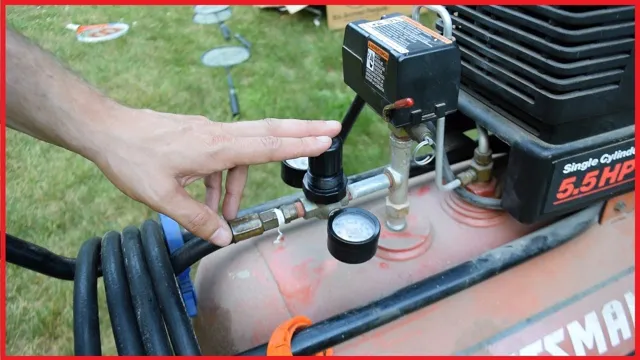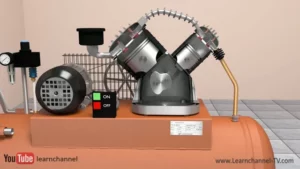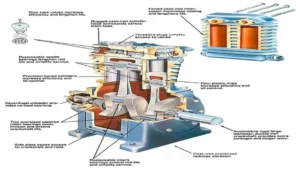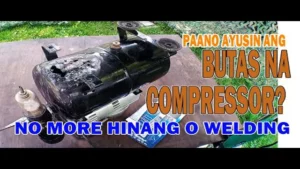Have you recently noticed that your air compressor isn’t functioning as it should? Does it feel like the air pressure isn’t strong enough, or is the compressor consistently failing to maintain the set pressure? If that’s the case, then it might be the air compressor regulator that needs fixing. Air compressors are an essential tool that requires regular maintenance to ensure that it operates efficiently. The air compressor regulator plays a crucial role in maintaining the pressure of the compressed air that goes into the tools you are using.
Without it, your air compressor won’t work correctly, and your tools won’t function as intended. However, repairing an air compressor regulator can be quite challenging, especially if you don’t know what you’re doing. The good news is, with the right tools and a little bit of guidance, you can quickly fix the regulator yourself and save money on repairs.
In this blog post, we’ll discuss the steps you need to follow to repair an air compressor regulator. We’ll cover everything from identifying the issue, disassembling the regulator, and fixing the problem, to reassembling it and testing it to see if it’s working correctly. So, grab your toolkit, put on your safety gear, and let’s get started on repairing your air compressor regulator!
What is an Air Compressor Regulator?
If you’re experiencing issues with your air compressor, the problem might be with the regulator. An air compressor regulator is an important component that controls the air pressure going into your tool. If it’s not working correctly, you may not be getting the desired pressure, which can impact your work and cause damage to the tool.
Repairing an air compressor regulator may seem daunting, but it’s actually a relatively easy process. You’ll need to start by shutting off the air supply and taking apart the regulator. Check for any damage or worn-out parts and replace them if necessary.
Once you’ve reassembled the regulator, test it out to ensure it’s working correctly. Remember to always prioritize safety when working on your air compressor regulator. With a bit of patience and the right tools, you can get your regulator working as good as new.
Definition of an Air Compressor Regulator
An air compressor regulator is a device that helps control the air pressure coming out of the compressor. It ensures that the air pressure released from the compressor remains constant and does not exceed the limitations of the tools or equipment being used. It works by adjusting the flow of air from the compressor, which in turn modifies the pressure exerted.
An air compressor regulator is a crucial part of any compressed air system as it helps prevent damage to the equipment, ensures efficiency while using compressed air, and guarantees safety for the user. The device helps regulate the pressure to suit the desired task, and without it, the user may experience poor performance while using air tools or equipment. Therefore, an air compressor regulator is a must-have for anyone using an air compressor.

Symptoms of a Broken Air Compressor Regulator
If you’re experiencing issues with the pressure of your air compressor, it’s possible that the regulator may be broken. The regulator is responsible for maintaining a consistent airflow and pressure level, and a malfunction can cause unstable performance. Symptoms of a faulty regulator include fluctuating pressure levels, air leaks at the regulator or the connections, and an inability to regulate the pressure appropriately.
If you notice any of these symptoms, it’s important to repair or replace the regulator as soon as possible to avoid further damage to your compressor. To repair the air compressor regulator, start by examining the regulator for any signs of damage or wear. If it appears to be damaged, replace it with a new one.
Otherwise, try cleaning or adjusting the regulator to improve its performance. Remember to always follow the manufacturer’s instructions and safety guidelines when working on your air compressor to avoid injury or damage to the equipment.
Low pressure or no pressure
If you’re experiencing low pressure or no pressure from your air compressor, it could be a sign of a broken regulator. The regulator is responsible for controlling the air pressure output, and when it’s not functioning properly, it can cause a decrease in air pressure. Some common symptoms of a broken regulator include inconsistent air pressure output, air pressure that doesn’t match your settings, and a regulator that’s stuck in a specific position.
You may also notice air leaking from the regulator itself, which can be a sign that it’s damaged or worn out. In any case, it’s important to address the issue as soon as possible to avoid any further damage to your equipment. It may be necessary to replace the regulator entirely, but in some cases, a simple repair may do the trick.
Either way, it’s important to have a professional inspect your equipment to ensure that it’s functioning properly and safely. So, if you’re experiencing low pressure from your air compressor, don’t ignore it – it could be a sign of a broken regulator that needs attention.
Inconsistent pressure
If you notice inconsistent pressure coming from your air compressor, then chances are that your regulator is broken. This is a common problem that arises when the regulator fails to maintain the proper level of air pressure required for your tools to work effectively. Symptoms of a broken air compressor regulator also include leaks, unusual noises, and a lack of pressure control.
When the regulator fails, it can result in a dangerous situation, as the pressure in the tank can build up to unsafe levels. It’s important to address this problem immediately to avoid any potential accidents. If your regulator is broken, it’s best to replace it with a high-quality one that can provide consistent pressure for all your air tools.
Don’t settle for a low-quality regulator that can’t handle the demands of your air compressor. Keep your tools running smoothly and safely with a reliable air compressor regulator.
Leaking air
Leaking air from an air compressor can be a frustrating problem to deal with. Often, the issue lies with a broken air compressor regulator. This component plays a crucial role in controlling the pressure and flow of air from the compressor.
If your regulator is broken, you may notice symptoms such as inconsistent air pressure output, constant leaking of air, or unusual compressor noises. Additionally, you may experience difficulties with your tools and other equipment not receiving enough air pressure to function properly. It’s essential to address a broken regulator as soon as possible to avoid potential safety hazards and equipment damage.
Regular maintenance and inspections of your air compressor can also help prevent issues from arising in the first place. By addressing a broken regulator promptly and taking preventative measures, you can save yourself time, money, and frustration in the long run.
Steps to Repair an Air Compressor Regulator
If your air compressor regulator is malfunctioning, don’t panic – it’s usually an easy fix that you can do yourself. First, turn off the compressor and relieve all pressure from the system. Then, disassemble the regulator and clean it thoroughly using a wire brush or solvent.
Check the internal components for any signs of damage or wear, and replace them if necessary. Make sure that all components are properly lubricated before reassembling the regulator. Once everything is back together, test the system to ensure proper function.
If the regulator still doesn’t work properly, you may need to replace it entirely. By following these simple steps, you can repair your air compressor regulator and get back to work in no time!
Step 1: Turn off the air compressor and disconnect it from the power source
If you’re experiencing issues with your air compressor regulator, don’t panic – it’s possible to repair it yourself with just a few simple steps. The first thing you need to do is turn off the air compressor and disconnect it from the power source. This is crucial for your safety as well as the proper function of the repair process.
Once you’ve done that, you can remove the regulator from the air compressor and start assessing the damage. Check for any visible cracks or signs of wear and tear. You can also use a pressure gauge to measure the output pressure and determine if the regulator is functioning properly.
If you identify any issues, you may need to replace the worn-out parts or adjust the settings. Remember to take your time and follow the manufacturer’s instructions to avoid causing further damage. By following these steps, you can restore your air compressor regulator to working order and keep your equipment running smoothly.
Step 2: Remove the regulator from the air compressor
If you’re experiencing pressure issues with your air compressor, repairing the regulator may be your solution. To begin the repair process, the first step is removing the regulator from the compressor. Start by unplugging the compressor and releasing any air pressure.
Next, locate the regulator by following the air hose leading out of the compressor. Once located, use a wrench to loosen and remove the bolts securing the regulator to the compressor. Gently pull the regulator away from the compressor, making sure to disconnect any electrical connections or hoses.
Once removed, inspect the regulator for any visible damage or wear and tear. Repair or replace any damaged components before reinstalling the regulator onto the compressor. By taking these steps, you’ll be well on your way to restoring proper pressure levels on your air compressor and getting back to work.
Step 3: Remove the cap from the regulator
air compressor regulator Now it’s time to move on to step three of repairing your air compressor regulator: removing the cap from the regulator. This step is crucial because it will allow you to access the inner workings of the regulator and identify any damage or wear that may be causing the issue. To remove the cap, you will need to use a wrench or pliers to loosen and then unscrew it from the body of the regulator.
Be sure to keep the regulator and cap separate to avoid losing any small parts inside. Once the cap is removed, take a good look inside the regulator. If there is any visible damage or wear to the parts, it may be time to replace the regulator entirely.
However, if everything looks intact, you can move on to the next step of the repair process. With that said, repairing an air compressor regulator can be a complex task, so if you’re uncomfortable or uncertain about any part of the process, it’s always best to seek the help of a professional.
Step 4: Inspect the regulator for damage or wear
When repairing an air compressor regulator, it is crucial to inspect it thoroughly for any damage or wear. Look for any cracks, bends, or other signs of wear and tear. If you notice any damage, it is essential to replace the regulator rather than attempting to repair it.
Attempting to fix a damaged regulator can result in further damage to the compressor or even cause injury to the user. If you find that the regulator is worn but not damaged, then it may be possible to repair it. However, it is still important to ensure that you have the necessary skills and knowledge to do so safely and effectively.
By taking the time to inspect the regulator carefully, you can identify any issues and determine the best course of action for repairing it, ensuring the longevity of your air compressor.
Step 5: Clean the regulator and replace any worn or damaged parts
Air Compressor Regulator When it comes to repairing an air compressor regulator, cleaning and replacing worn or damaged parts is an important step. Start by disconnecting the regulator from the air compressor and releasing any pressure that may be inside. Then, use a soft-bristled brush or a cloth to clean the regulator’s exterior and interior parts.
Next, inspect the filter, diaphragm, and valve for any signs of wear or damage. If any parts are worn out, they should be replaced to ensure that the regulator functions properly. It’s important to use the correct replacement parts for your specific regulator model.
After cleaning and replacing any necessary parts, reassemble the regulator and test it to ensure it’s functioning correctly. Remember that regular maintenance can help prevent the need for future repairs of your air compressor regulator. By properly cleaning and maintaining your regulator, you can ensure that your air compressor operates efficiently and effectively, providing you with the compressed air you need for your equipment and tools.
Step 6: Reassemble the regulator and reinstall it on the air compressor
After cleaning the regulator, it’s time to put it back together. Firstly, place the diaphragm and the spring back into the hole in the regulator body. Then, replace the regulator cover and tighten the screws using a screwdriver.
Once the cover is firmly in place, slide the regulator adjustment knob back onto the shaft and tighten the locking screw. Then, position the bracket back onto the regulator and secure it with screws. Finally, reattach the airline to the regulator and screw it in tightly.
Congratulations! You have successfully repaired your air compressor regulator. Now, it’s time to put it back on the air compressor and test it out. Turn on your air compressor and adjust the regulator pressure to a desired level using the adjustment knob.
Remember to take care of your air compressor regularly to keep it in good condition and avoid any potential future problems.
Conclusion
In conclusion, repairing an air compressor regulator may seem daunting at first, but with the right tools and a little bit of know-how, it is an achievable task for even the novice DIY-er. Just remember to approach the repair with caution and safety in mind, properly diagnose the issue before beginning work, and be prepared to put in a bit of elbow grease. And just like that, you’ll be blowing away the competition – and the debris on your workbench – in no time!”
FAQs
What is an air compressor regulator and what is its function?
An air compressor regulator is a device that controls the output pressure of air from the compressor. It ensures that the pressure remains constant and at a safe level.
What are the common problems faced with air compressor regulators?
The most common problems with air compressor regulators include leakage, faulty pressure gauges, and inconsistent air pressure.
How do I diagnose a faulty air compressor regulator?
To diagnose a faulty air compressor regulator, check for air leaks, inspect the pressure gauge, and use a multimeter to test the regulator’s electrical connections.
Can I repair a faulty air compressor regulator or should I replace it?
In most cases, it is more cost-effective to replace a faulty air compressor regulator rather than repairing it. However, if the problem is minor, such as a clogged air filter, it may be possible to repair it.
How do I replace an air compressor regulator?
To replace an air compressor regulator, turn off the compressor, remove the old regulator, and install the new regulator. Then, adjust the output pressure to the desired level.
What should I consider when choosing a new air compressor regulator?
When choosing a new air compressor regulator, consider the maximum output pressure, compatibility with your compressor, and the type of application you will be using it for.
Can I install an air compressor regulator myself or should I hire a professional?
Installing an air compressor regulator can be done by someone with moderate DIY skills. However, if you are not confident in your abilities, it is recommended to hire a professional to ensure proper installation and safety.







